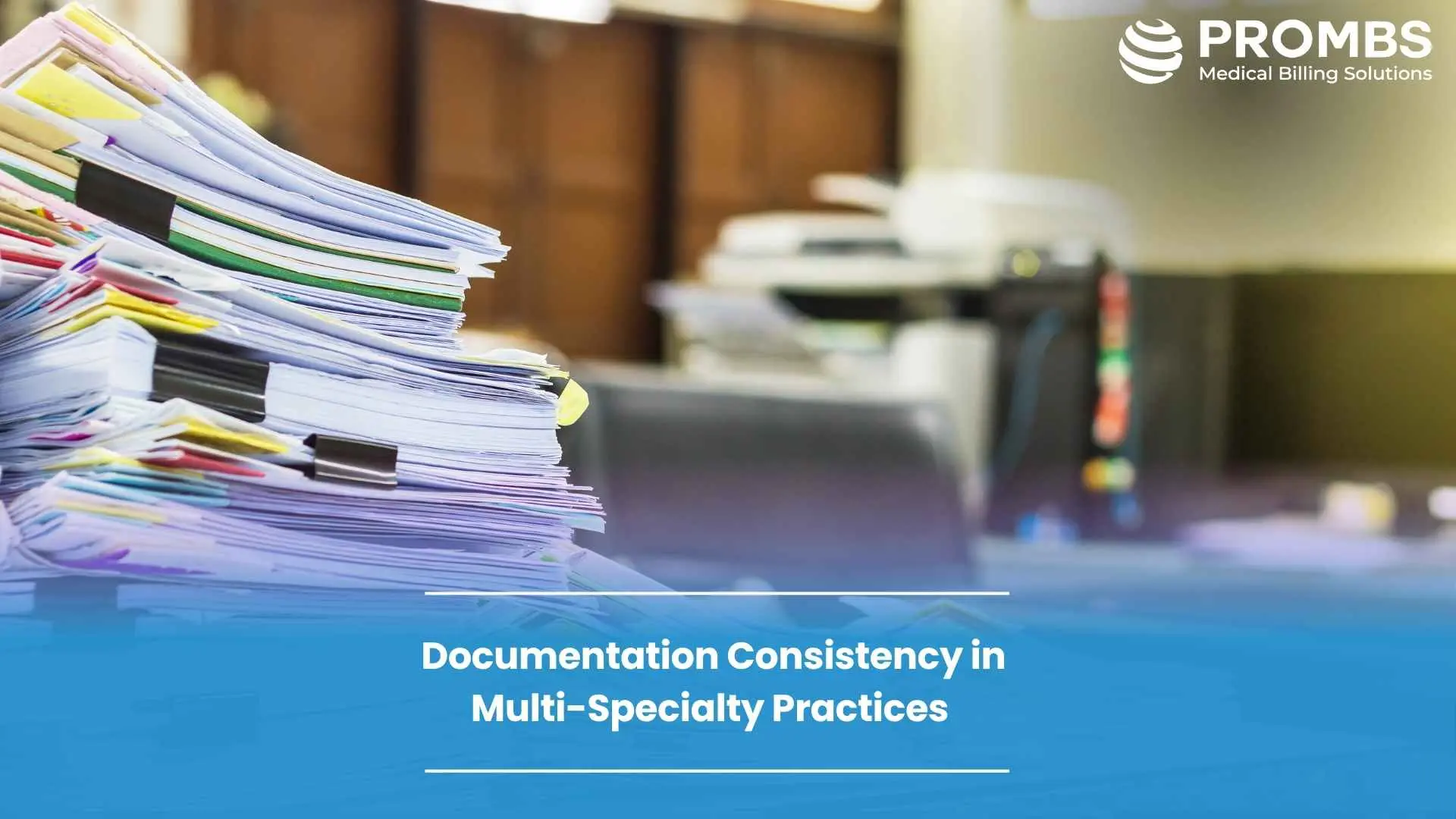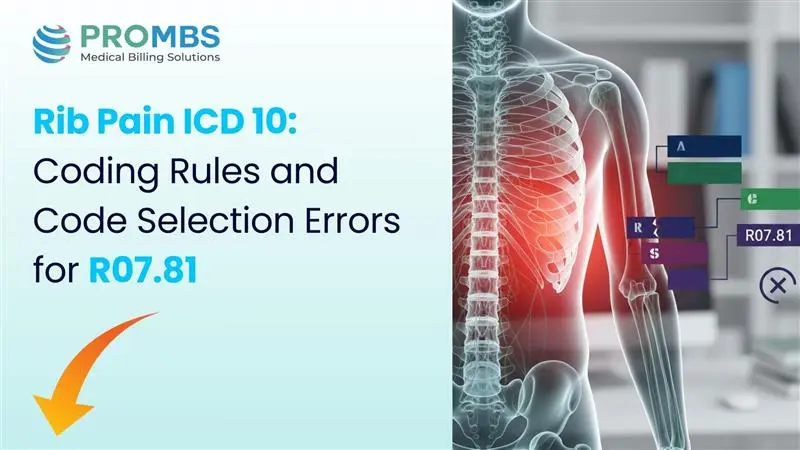Documentation Consistency In Multi-Specialty practices is not a routine task. It is the core of billing accuracy, compliance, and efficiency. For medical billing teams, doctors, and hospitals, it decides whether claims move or stall. Every specialty has its rhythm. Orthopedics writes in motion. Cardiology writes in beats. Behavioral health writes in tone and observation. When those rhythms drift apart, problems begin. Claims slow. Audits appear. Revenue slips away. According to HFMA, almost 30 percent of claim errors come from inconsistent documentation.
That number speaks loudly. It means one out of every three denials could have been avoided. Think about that. Every third claim error is not a payer issue. It is a documentation issue. Something that could have been fixed before submission. Now picture this across a hospital or a large practice. Orthopedics writes one way. Cardiology another. Behavioral health records look different again. Each department tells its own version of the same story.
For billing teams, that means extra hours sorting through mismatched details. For physicians, it means frustration when their notes are questioned. For administrators, it means money left on the table. Inconsistent documentation does not just confuse coders. It weakens compliance, slows audits, and disrupts patient care. One missing detail can turn an approved claim into a denial. One incomplete log can freeze payment for weeks.
Consistency is not just paperwork. It is revenue protection. It is what turns uncertainty into clarity. So how can teams across departments stay aligned? The answer is simple. Create structure. Set shared standards. Communicate clearly. Let’s walk through how to make that happen.
Why Documentation Consistency is Important Across Specialties
Every patient record tells a story. The question is whether everyone tells it the same way. Inconsistent notes create chaos. Coders guess. Billers chase. Payers reject. CMS requires documentation to support every code billed. If it doesn’t, the claim is invalid. Even skilled physicians lose revenue when their notes don’t prove the care provided.
Documentation errors don’t happen in isolation. They repeat in patterns across departments and providers. The table below shows how simple gaps can lead to big problems in the revenue cycle.
| Documentation Issue | Impact on Billing and Compliance | Resulting Consequence |
|---|---|---|
| Missing time log | Time-based services cannot be validated | Claim delayed or denied |
| Unlinked diagnosis code | CPT and ICD-10 mismatch | Denial for lack of medical necessity |
| Unsigned provider note | Encounter marked incomplete | Payment on hold until corrected |
| Incomplete encounter details | Lack of clarity for coding | Reduced or rejected reimbursement |
These small gaps multiply fast. Billing teams spend hours chasing corrections. Doctors recheck old notes. Patients wait while payments stay stuck in limbo. Consistency solves that. It keeps records complete, connected, and clear. When documentation is right the first time, billing flows faster, audits go smoother, and providers stay focused on care instead of corrections.
Did You Know?
According to HFMA, almost 30 percent of claim errors come from inconsistent documentation. That means nearly one in three denials could have been prevented before the claim ever left your system. Consistent documentation protects your revenue, strengthens compliance, and improves communication between providers and payers.
What Are the Common Documentation Gaps Across Specialties
Where do hospitals, clinics, and billing teams fall short? The truth is, the problems repeat more often than anyone admits. Documentation Consistency In Multi-Specialty is not a piece of cake. The same documentation gaps appear month after month, no matter the size of the practice or the system used. They start small but spread fast, costing time, clarity, and clean claims along the way. The below Infographic shows the common documentation gaps across specialties:

The American Medical Association (AMA) warns against cloned documentation. When the same text repeats across records, it confuses coders and auditors. One copied mistake can create a chain of billing errors. These errors do more than cause denials. They interrupt communication between departments and weaken patient care. A therapist’s note should inform the physician. A physician’s note should guide the billing team. If the details do not connect, everyone loses clarity. To fix this, you need structure that allows each specialty to work differently while still following one shared system.
Standardizing EHR Templates for Multiple Specialties
Your electronic health record (EHR) is the foundation of documentation. It should support variation but keep one consistent framework. CMS and OIG both recommend structured, specialty-specific templates. These templates make documentation accurate and audit-ready. A single SOAP note format can fit all departments. The core stays the same, while the fields shift by specialty.
- Cardiology can include ECG readings and test data.
- Orthopedics can capture movement range and procedure notes.
- Behavioral health can track symptom scores and progress updates.
The Office of the National Coordinator for Health IT (ONC) explains that structured templates reduce variation and improve data quality. How can practices design effective templates? Ask each specialty what data it needs to document clearly. Combine those requirements into one shared design. When the screen layout feels familiar across departments, consistency becomes habit.
Training and Cross-Specialty Documentation Audits
Training builds skill. Auditing builds accuracy. Both keep consistency alive. Most practices train once and then move on. Over time, documentation standards drift. OIG Compliance Guidance recommends ongoing internal audits for all high-volume services. Quarterly reviews work best. Let each department audit another.
Have the orthopedic team review therapy notes. Let billing staff check cardiology records for modifier accuracy. When people look beyond their own area, they see problems others miss. Audits also need focus and direction. A clear plan helps teams know what to look for and how to act on what they find.
| Audit Focus Area | What to Review | Common Findings | Corrective Action |
|---|---|---|---|
| Orthopedics → Therapy | Check therapy minutes, note time clearly, confirm modifier use. | Time logs missing. CPT links off. Sessions not tracked. | Add clear time fields. Train staff on accurate entry. Keep every session documented and verified. |
| Billing → Cardiology | Review modifiers, diagnosis links, and test documentation. | Wrong modifier. ICD-10 not linked. Data incomplete. | Update the billing guide. Refresh coding accuracy. Build quick checks before submission. |
| Behavioral Health → General Medicine | Look for complete progress notes, correct duration, and valid credentials. | Credentials missing. Notes left open. Duration not logged. | Fix templates to require credentials. Train on timely completion. Keep every record closed and signed. |
| Compliance → All Departments | Audit EHR completeness, signatures, and coding consistency. | Late sign-offs. Missing audit fields. Inconsistent coding. | Reinforce same-day completion. Run spot checks weekly. Keep every record audit-ready. |
Use audit results to refine templates and adjust training. Discuss findings in team meetings so everyone learns together. Audits are not about blame. They are about growth. Every error caught early saves hours of cleanup later. Audits show patterns. They highlight what works and what needs fixing. Maybe one team forgets to link diagnoses. Maybe another leaves time fields blank.
Once you see it, you can fix it for good. Share results openly. Let everyone learn from them. When people see progress, they take ownership. A good audit builds trust. It turns mistakes into lessons and lessons into stronger systems. Done regularly, it keeps documentation sharp and consistent across every department.
Did You Know?
The OIG found that practices running regular internal audits cut claim denials by nearly 40 percent. CMS adds that when those audit results feed back into daily workflows, billing accuracy jumps fast. Every review pays off. The more you check your notes, the fewer errors ever reach the payer.
Leveraging Technology for Real-Time Documentation Consistency In Multi-Specialty
Can technology keep documentation consistent? Absolutely. But only if it works in real time. Modern EHR systems are smarter than ever. They do more than store notes. They think, scan, and flag what is missing before a claim is sent. Unsigned notes? Flagged. Mismatched CPT and ICD-10 codes? Flagged. Incomplete time entries? Flagged again.
CMS’s EHR Incentive Program confirms that automation improves claim accuracy and reduces rework. Technology does not slow you down. It saves you from repeating the same task twice. AI-driven tools now check documentation across every specialty. If a cardiologist forgets to link a diagnosis, the system spots it. If a therapist skips time documentation, it alerts them before the claim moves forward. These systems catch mistakes in seconds, long before they turn into denials. That is how teams stay one step ahead.
| Technology Feature | Purpose | Impact on Workflow |
|---|---|---|
| AI-driven validation | Scans for missing details and mismatched codes. Finds problems before they spread. | Stops denials before claims go out. Keeps billing clean and accurate. |
| Real-time alerts | Flags missing data the moment it happens. Keeps everyone informed and on track. | Cuts rework time. Fixes issues in seconds instead of days. |
| EHR automation tools | Checks every note for completeness. Ensures documentation meets payer standards. | Keeps records ready for review. Moves claims through faster. |
| Analytics dashboards | Tracks trends and error patterns across all departments. Turns data into direction. | Guides staff training. Helps teams improve where it matters most. |
Automation does not replace human review. It amplifies it. It helps providers and billing teams work faster and with more confidence. Why wait for a denial when technology can stop it before it starts? Consistency begins with people, but technology keeps it strong every day.
What Is the Best Way to Build a Culture of Consistency and Accountability
Templates and tools help. Culture makes it permanent. For Documentation Consistency In Multi-specialty, a consistent culture grows when everyone takes ownership. Each note, each claim, and each review should meet the same standard. Culture is built in small choices. A coder double-checking a code. A provider signing notes before leaving. A billing lead reminding the team that accuracy matters. When people care about getting it right, consistency becomes habit. Audits get easier. Denials drop. The whole workflow starts to move smoother. Culture is not policy. It’s action. It’s what turns good systems into great ones.
Encourage providers to:
- Sign and complete notes the same day
- Avoid copy-paste shortcuts
- Double-check codes before submission
- Track audit feedback and measure improvement
The AMA reminds providers that timely sign-offs reduce compliance risk and strengthen communication. A delayed signature may sound minor but it can derail a payer audit. For billing teams and hospital administrators, culture means setting expectations and celebrating accuracy. When teams see progress, they stay engaged.
Did You Know?
HFMA reports that consistent documentation reduces claim rework time by up to 25 percent. That is time your team can spend on patient care and revenue growth instead of corrections. According to CMS internal audit data, every incomplete note adds about five minutes of follow-up work. Across hundreds of encounters, that equals full days lost. Consistency is not a form to fill. It is a habit to build.
Partner with Pro-MBS for Documentation Compliance and Audit Support
At Pro-MBS, we help practices achieve Documentation Consistency In Multi-Specialty practices through structured audits and smarter workflows. Consistency does not happen by accident. It takes a plan, a process, and a partner who understands both billing and compliance. Pro-MBS helps hospitals, clinics, and multi-specialty groups achieve documentation alignment. Our team builds specialty-based EHR templates, conducts compliance audits, and trains staff to document accurately and confidently.
When your documentation is consistent, your claims move faster. Your audit results stay clean. Your teams spend less time fixing and more time doing. Pro-MBS makes sure every chart tells one complete, accurate, and compliant story. At the end of the day, consistency isn’t paperwork. It’s peace of mind; for your providers, your patients, and your billing team.
Frequently Asked Questions
Why is consistency important in documentation?
Because chaos hides in inconsistency. Documentation Consistency In Multi-Specialty keeps your story straight, one patient, one truth. When notes match, claims move. When they don’t, money stalls. Consistency is not paperwork. It is armor. At Pro-MBS, we build that armor for you. Let’s turn accuracy into revenue.
What is document consistency?
Document Consistency means one rhythm, one voice. Every specialty writes differently, but the structure stays the same. It keeps coders steady, auditors calm, and billing flawless. At Pro-MBS, we weave that rhythm into your daily work until precision becomes habit. Partner with Pro-MBS and own your rhythm.
What are the five quality guidelines for documentation?
Accuracy. Completeness. Legibility. Timeliness. Accountability. Five words that decide if your claim stands or falls. These are the pillars of Medical Documentation Best Practices, the difference between clean payment and costly delay. Pro-MBS makes sure every note holds firm.
What are the three elements of good documentation?
Clarity cuts confusion. Consistency builds trust. Compliance protects your revenue. Miss one, and everything wobbles. Pro-MBS trains your teams to master all three so every record speaks clearly and gets paid fast. Let’s rebuild precision together.
What are the FDA guidelines for good documentation practices?
The FDA’s ALCOA+ rules stand for Attributable, Legible, Contemporaneous, Original, Accurate. Five guards of truth. They keep your records real and compliant. At Pro-MBS, we design EHR structures that meet these standards, clear, traceable, and bulletproof. Keep every log unbreakable with Pro-MBS.
How can multi-specialty practices improve documentation consistency?
Structure. Training. Audits. Repeat. That is how Documentation Consistency In Multi-Specialty becomes second nature. Pro-MBS aligns every department, rewires every workflow, and turns chaos into clarity. Start your documentation rebuild with Pro-MBS.
What role does technology play in maintaining documentation consistency?
AI sees what humans miss. EHR automation catches errors before they breathe. Medical Documentation Best Practices now live inside code, but code still needs judgment. Pro-MBS blends both: machine precision and human sense. Automate accuracy with Pro-MBS.
How often should documentation audits be performed?
Quarterly. No excuses. Consistent Documentation in Healthcare fades without checkups. Audits expose drift before it becomes damage. Pro-MBS runs audits that do not just find mistakes, they fix the system behind them. Keep your records battle-ready with Pro-MBS.
Why do inconsistent notes lead to claim denials?
Because they break the chain. Care. Code. Claim. One missing link and the whole line falls apart. Documentation Consistency In Multi-Specialty locks those links tight. Pro-MBS builds systems that never lose the thread. Stop denials before they strike.
How do standardized EHR templates support multi-specialty practices?
Templates are discipline made visible. They keep every note in rhythm, cardiology, orthopedics, behavioral health, all writing in sync. That is Documentation Consistency In Multi-Specialty at work. Pro-MBS builds these templates so you can build clean claims. Let’s standardize your success.



